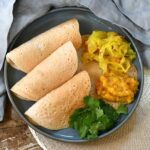Fermented Rice Dosa
Dosas are a traditional Indian fermented crepe. This rice dosa recipe is naturally gluten-free and vegan. The batter only takes about 24 hours to naturally ferment! It has a rich, sour flavor that is delicious hot, and fresh from the pan. See the section above for filling options.
- Prep Time: 20 minutes
- Cook Time: 15 minutes
- Total Time: 35 minutes
- Yield: 8 dosas 1x
- Category: Main Dish
- Method: Fermented
- Cuisine: Indian
- Diet: Gluten Free
Ingredients
Units
Scale
- 1 cup white short-grained rice (see notes)
- 1/3 cup urad dal (or split red lentils)
- Filtered water (chlorine-free for soaking and fermenting)
- 1/8 tsp of ground fenugreek
- 1/2 tsp salt
Instructions
Fermenting
- The rice and the dal need to soak individually for 3 to 6 hours. So place each of them in separate bowls and cover with water.
- After soaking, drain the water from the lentils, and scrape into a blender. Use a few tablespoons of water to rinse any remaining lentils from the bowl and add them to the blender. Grind until smooth and frothy.
- When the lentils are fully ground, drain the rice and add it to the blender as well. Continue grinding until it comes together in a smooth batter. Feel free to add a few more tablespoons of water, if necessary, to help with grinding.
- Scrape the ground dal and rice into a large glass bowl or measuring cup for fermenting. You can use a bit more filtered water to get any remaining ground rice and dal from the bottom of the blender. The batter needs to be 2 1/2 cups in total volume, so add more filtered water if necessary.
- Stir in the fenugreek. Cover the container with a tea towel and leave it somewhere warm to ferment for at least 12 hours or up to 48 hours. Give it a good stir with a fork about twice a day. The dosa batter is officially ready when it is nice and bubbly, but you can be flexible to fit your schedule. The longer it ferments the sourer it will be, so don’t let it go much more than 48 hours.
Cooking
- When you’re ready to cook the dosas, heat a frying pan on medium. I use a cast-iron pan, but any non-stick pan will work.
- Add the salt to the dosa batter and stir gently to keep the frothiness. The final batter should have a thick, pourable consistency, so add a bit more water if necessary.
- Brush on a thin layer of oil in your pan. Then ladle 1/4 cup of batter into the pan and spread it around with the back of a spoon to make a thin layer.
- The dosa is cooked when the bottom side has started to brown and the top side is dry. You can either serve it like this or flip the dosa over to lightly toast the other side. You want the dosa to be fully cooked, but still soft enough to fold and roll.
- Serve fresh and hot with your choice of fillings.
Notes
- If rice isn’t your thing, try my millet and red lentil dosa recipe instead!
- The amount of time it will take your dosa batter to ferment depends on the temperature and local strains of yeast. Unlike bread, a precise doubling of the batter isn’t required, but do expect it to bubble up.
- It can take a bit of practice to make nicely formed dosas. Just make sure that you oil your pan each time as the dosas don’t have any oil and they will seize otherwise.
- Short-grain rice is better than long-grain because of its starchiness, however, idli rice
(if you can find it) is the best rice to use.
Nutrition
- Serving Size: 1 dosa
- Calories: 113
- Sugar: 0.2g
- Sodium: 149mg
- Fat: 0.2g
- Saturated Fat: 0.1g
- Carbohydrates: 23.3g
- Fiber: 2.7g
- Protein: 3.7g
- Cholesterol: 0mg
Find it online: https://www.fermentingforfoodies.com/homemade-rice-dosas/
